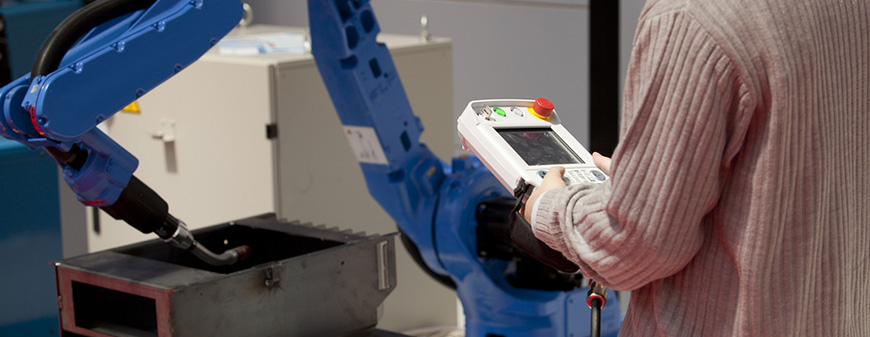TWS is a Great Training Option for Everyone
Learn more about how we can prepare you to advance your career.
“Upskilling” is the new favorite catchphrase of reporters and journalists, often making news headlines alongside coverage of the skilled labor shortage.
Why? One reason for the skills gap is that companies can’t find workers with the right skills. Teaching workers new skills can be a solution to the problem.[1]
How is this all relevant to you as a welding student? Well, technology is changing the welding industry just as it is many other sectors.[2] Welders can upskill to keep up with these changes, especially in manufacturing.[3]
However, upskilling isn’t an entirely new concept, either. Workers, including welders, have been learning new skills to advance in their fields for some time.
Have You Considered a Career in the Skilled Trades?
Fill out the form to recieve a no obligation info packet.
Read more about the upskilling trend and its impact on the welding industry in this article.
What Does It Mean to Upskill?
“In a world where technology is changing jobs and people are living longer lives with more diverse careers, organizations have not only an opportunity, but a responsibility, to reinvent learning so that it integrates into the flow of work—and life.” –Deloitte Insights
What is upskilling? The definition of upskilling is pretty straightforward: “the process of learning new skills or of teaching workers new skills,” according Cambridge Dictionary.
But workers have been learning new skills for ages, right? That’s what you’re doing now in welding training: learning to fuse metal to improve your chances of landing entry-level positions in the industry.[4]
So, how is upskilling different? It’s not, really, but the need for new and established workers to refresh their skills may be growing. It’s a result of the impact of technology on processes and the fact that modern workers must plan for careers lasting 50-60 years out of a possible 100-year lifespan:[5]
- Research firm, Deloitte Insights, rated the need to improve learning and development (L&D) as its top rated human capital trend for 2019.[6]
- Eighty-six percent of respondents in Deloitte’s global human capital trends survey ranked the issue as important or very important.[7]
- Fifty-four percent of all employees will need significant upskilling or reskilling in the next three years, indicates the World Economic Forum’s The Future of Jobs Report.
- Around the world, it takes an average of 42 days to fill an open job today due to tight labor markets for skilled workers and low unemployment.[8]
How Welders Can Upskill for Modern Manufacturing

Putting 61 percent of welders to work, manufacturing is the top employer of these tradesmen and women. And, in recent years, technology has changed the industry dramatically with the advent of artificial intelligence, analytics and the Internet of Things. While not as new, automation in manufacturing has also played a major role in the shift in how goods get made in America and globally.[9]
Rather than steal jobs from human workers, robots and other technologies are likely to create them—but different types of positions requiring new skillsets.[10] The robotic welder operator occupation is an example of how welders can upskill to meet the demands of an evolving manufacturing industry.
In the semi- or fully-automated process of robotic welding, robots may position and secure parts to be joined and may weld the pieces together, as well. Computers control these robots. It is the job of a robotic welder operator to program these computers.[11][12]
A worker with basic welding training could take classes in robotic equipment programming to upskill for such positions.[13][14][15]
The need for workers with the skills to operate robotic welding equipment is expected to increase in the coming years as automation becomes more and more common in the manufacturing industry, making it yet another welding career path for workers to consider.[16]
Welders in other fields can upskill to advance their careers by earning welding certifications from organizations like these:
Why Is Upskilling Important for Welders?
Employers in the U.S. and around the world report that skilled trades positions—those for electricians and welders—are the number one hardest to fill.
Deloitte predicts an estimated 2.4 million positions in manufacturing will go unfilled between 2018 and 2028 due to the skills gap, particularly those related to skilled production.
What does this mean for the welders with the right skills? Potentially, jobs, security, advancement and even greater pay. That’s the upskilling advantage.
With the right skills, a worker may be able to land a welding job in a host of industries: from structural welding to pipefitting to inspection.
[1] https://www.careeronestop.org/BusinessCenter/RecruitAndHire/IdentifyYourHiringNeeds/the-skills-gap.aspx
[2] https://www2.deloitte.com/us/en/pages/manufacturing/articles/future-of-manufacturing-skills-gap-study.html
[3] https://www.realityworks.com/the-importance-of-upskilling/
[4] https://www.bls.gov/ooh/production/welders-cutters-solderers-and-brazers.htm#tab-4
[5] https://www2.deloitte.com/insights/us/en/focus/human-capital-trends/2019/reskilling-upskilling-the-future-of-learning-and-development.html#endnote-sup-3
[6] https://www2.deloitte.com/insights/us/en/focus/human-capital-trends/2019/reskilling-upskilling-the-future-of-learning-and-development.html
[7] https://www2.deloitte.com/insights/us/en/focus/human-capital-trends/2019/reskilling-upskilling-the-future-of-learning-and-development.html
[8] https://www2.deloitte.com/insights/us/en/focus/human-capital-trends/2019/reskilling-upskilling-the-future-of-learning-and-development.html#endnote-sup-3
[9] https://www2.deloitte.com/us/en/pages/manufacturing/articles/future-of-manufacturing-skills-gap-study.html
[10] https://www2.deloitte.com/us/en/pages/manufacturing/articles/future-of-manufacturing-skills-gap-study.html
[11] https://www.onetonline.org/link/summary/51-4122.00
[12] https://www.onetonline.org/link/summary/51-4011.00
[13] https://awo.aws.org/2014/07/i-welding-robots/
[14] https://www.robots.com/faq/what-is-covered-in-the-robot-training-class
[15] https://www.bakersgas.com/weldmyworld/2011/03/16/free-program-to-learn-robotic-welding/
[16] https://app.aws.org/research/vision.pdf
This blog has been labeled as archived as it may no longer contain the most up-to-date data. For a list of all current blog posts, please visit our blog homepage at https://www.tws.edu/blog/







